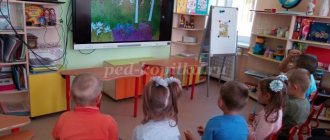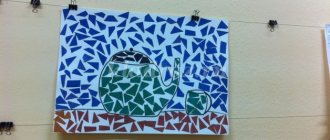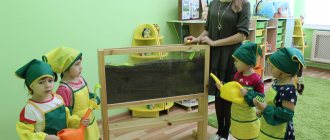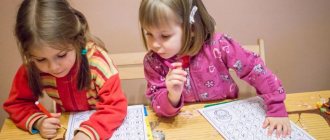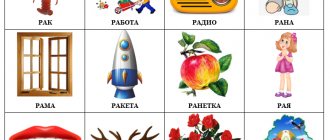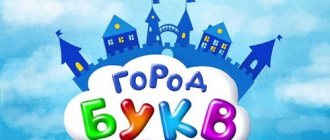Game 1. We treat guests. We play with words.
We learn to form new words from known ones (names of tableware).
Meet Tanya and Vanya. Their friends came to visit Tanya and Vanya. The guys invited the guests to the table. Look at the pictures and name what dishes the children put on the table. For oil - a butter dish, and for salt -...? (Salt shaker) For soup - a tureen, for sweets - ...? (candy bowl), for sugar - ...? (sugar bowl), for bread -... (bread box). For milk - a milk jug, for salad - ...? (salad bowl), and for coffee -...? (coffee pot). What kind of dishes does your mother put on the table when guests come to you? (carefully look at the dishes at home, name them, look at the details and name them - handle, spout, lid, bottom)
Listen to a poem about dishes. (The poem “Dispute” will help the child learn to correctly name different dishes. While reading, show the child the dishes shown in the picture)
I came up with this poem for classes with children, and they really liked it. It also helped me quickly learn the names of different utensils. I hope that you and your children will get great pleasure from the poems in pictures.
You will find this poem in pictures, as well as other tasks in pictures, in the article “Pictures of dishes for children”
You will find a presentation on this poem with pictures in good resolution for more convenient viewing with children in our VKontakte group “Child development from birth to school” (section of the “Documents” group on the right under the group video)
Dispute.
Once the dishes started arguing, Who is the most important in the world? “I’m more important,” the teapot told everyone. I warm tea for people.
“And without us they won’t be able to eat the soup. A spoon is also a friend to people.” Then the pots answered them: “You can’t cook dinner without us!”
The frying pan hissed: “That’s what I wanted to say. I fry cutlets for people, and potatoes, and omelettes.”
Stop this argument, useless conversation. We need all the dishes, each one is important to us.
We put butter in a butter dish , pour salt into a salt shaker . We put bread in the bread bin , and take soup from the tureen .
We also have a kettle with tea. We don’t miss drinking tea And pour sweet sugar from a bright sugar bowl
There is a milk jug with milk and a coffee pot with a rim. There are candies in the candy bowl for both Masha and Sveta.
There are a lot of different dishes and we need them everywhere! And we cook, and we eat, and we store food in it. (Author - Valasina A.V.)
Why do people need different dishes? What would happen if there were no dishes?
Read the poem again and ask your child to finish the words after you - the names of the utensils. For example, “We put butter in the oil...(liner), pour salt in the salt...(lonker)."
Game 2. What's missing?
We learn to accurately name the parts of the dishes. We learn to use the genitive case in speech.
Let's remember the fairy tale by K.I. Chukovsky “Fedorino's grief”.
Tell me why the dishes ran away from Fedora? Look at Fedora's broken dishes. What is missing from a cup, pan, teapot?
“A cup without...(handle).”
“A saucepan without...(lid).”
“A teapot without ... (spout).”
-Is it convenient to use a cup without a handle? Why? Why do cups have a handle? What other utensils have a handle? (At the frying pan, at the saucepan, at the kettle, at the milk jug, at the coffee pot). Why do these items need handles?
-Why do you need a lid on the pan? What other items have you seen with lids?
-Can I use a kettle without a spout? Why? What other objects have a spout? (At the watering can, at the coffee pot, at the milkman). What is the spout for?
Why did the dishes return to Fedora? What would happen if the dishes didn't come home? How did Fedora begin to take care of her dishes? (Washed it, cleaned it, doused it with boiling water, rinsed it, didn’t beat it...)
Game 3. Guess the riddle.
We learn to reason, identify and accurately name the characteristics of objects.
You will need three toys or three pictures for your child to choose a answer: a frying pan, a saucepan, a kettle (but in no case should the kettle be the first in the row).
Ask your child to guess the riddle:
“I puff, puff, puff, I don’t want to get warm anymore. The lid rang loudly: “Drink tea, the water has boiled!” What is this? Find the answer.
Do not rush to give the correct answer, give the child the opportunity to reason and think. Be sure to provoke him to prove his opinion by making a deliberate mistake. You can say: “Why did you think it was a teapot? Maybe it’s a saucepan, it’s also puffing?” Let the child listen to the riddle again and try to prove his opinion. Then ask again: “Or maybe it’s a frying pan, does it get hot too?” Re-read the riddle again and find in it the signs of the object, name them together with the child: it has a lid, it puffs and warms itself on the stove, it boils water for tea. Why isn’t this a frying pan?
These deliberate mistakes, which encourage the baby to reason, can be made by Mishka - Toropyzhka or Dunno, whom you invite to solve riddles with the baby.
Tips for parents:
- Remember that it is at the age of 3-4 that a child’s word creation begins. Don’t scold your child for making up words like “for salt – Solnitsa, for butter – Maslenitsa (Shrovetide).” The child’s word creativity must be encouraged. It indicates the child’s experimentation with words, his active mental activity. Without playing with words, it is impossible to fully master the grammar of your native language in all its completeness and richness! If you make a mistake, do not repeat it after your child, just immediately say the correct version of the word: “People agreed to call the utensils for butter a butter dish, and the utensils for salt a salt shaker.”
— Games for children 3 years old should not be long. They are always funny, entertaining, and built in dialogue with the child. Having learned the names of utensils in the game, the purpose of their parts, be sure to repeat this material (look at the dishes at home, at your grandmother’s, in the store, draw your child’s attention to the interesting shapes of handles, lids, spouts, try to sketch them; if your child is already 4- 5 years, you can look at the dishes in the museum - how they differ from our dishes at home, what they are called, what they were previously used for). When examining objects, be sure to give them to the baby’s hands so that he can run his finger along the contour, determining their shape; I tried holding it with the handle and without the handle - whichever was more convenient.
continued games with children 3 years old and older in the following article: “Dishes: tasks in pictures for children”
all the pictures of the article for more convenient viewing with children in our VKontakte group (see the group section “Documents” - presentation “Dishes”, the presentation is available for editing). Or watch the presentation below. To view full screen, you need to click the arrow icon in the lower right corner of the screen.
History of dishes for children
It is difficult to imagine the life of a modern person without dishes. The history of the appearance of dishes is closely connected with the history of the development of humanity as a whole. The shape, size and quality of dishes have always reflected a certain stage of human development. The appearance of dishes occurred around the 7th millennium BC.
Primitive people learned to weave baskets from twigs, and to coat these baskets with clay for strength. The baskets were left to dry in the sun - this allowed them to become durable. The result was the first container in which dry foods, such as cereals, could be stored. It was impossible to pour water there - the clay would immediately become soggy. The clay basket accidentally fell into the fire, and people saw that after firing it became very strong. Now it was possible to store liquids in it and even cook something over a fire. This is how primitive people learned to sculpt and fire clay pots. In ancient Greece and Rome, ceramic dishes reached their peak - images of gods and heroes were skillfully applied to any object. Clay dishes are still popular today, because this material is one of the safest for human health.
Pieces of copper ore sometimes fell into the fire along with the wood. And people have noticed how copper changes shape at high temperatures, so it can now be sharpened or bent. This is how the first metal utensils appeared.
For a long time, dishes in Rus' were only made of wood and clay. Instead of modern saucepans, ceramic pots of different sizes and shapes were used. Much later, cast iron pots made from cast iron appeared. Even later, dishes made of glass, silver and porcelain appeared. Over time, Russian craftsmen learned to create beautiful dishes with unique paintings.
Even before the advent of plates, food was placed directly on the table and eaten with hands. A large piece of bread served as an individual “plate” for each person; food was placed in its recess. It is interesting that the first plates appeared among the French kings and only for the most ceremonial receptions. Moreover, they were all only square in shape.
If we talk about cutlery, then the knife appeared first and only then spoons and forks. Of course, at first the knife was not a cutlery; it was used by men for hunting. It was a heavy stone product, and only later did the knives become more convenient - metal. Knives for the kitchen and for other needs were no different, and therefore they were dangerous. In the 18th century, Napoleon ordered the tip of a table knife to be blunted and rounded for safety.
The first spoons were mostly made of wood, sometimes they were carved from bone or even stone. In Greece, suitable shells were used instead of spoons. In Rus' it was customary to carry your own spoon with you. It was placed in the bosom, in a special box, tucked into a belt or behind the top of a boot. Dahl's dictionary lists many types of spoons for different purposes.
The very first fork had only two teeth and was absolutely flat, without bends, it could not be used to scoop up food. It was much larger than a modern device, because its direct purpose was to pull large pieces of meat from a cauldron or brazier. The appearance of the fork dates back to the 9th century. Maria Mniszech brought the fork to Russia, which caused great surprise at court.
Another important type of cookware is the frying pan; at first it was an ordinary flat stone. And food was practically not fried on it, it was simply dried. Frying pans made of metal and ceramics appeared a little later. With their appearance, housewives were able to expand the menu, because now food could be truly fried.
Nowadays, many dishes are made of plastic. These are mainly plastic containers for storing food, children's dishes or disposable items for picnics. A short journey into history allows you to appreciate how rich and varied the arsenal of tableware is in our time.
Progress of the lesson to study the topic “Utensils”
1. Lesson “Magic bag”
“I have this beautiful bag, and there’s something in it.” Let's see what's inside? Children take turns taking objects out of the bag. Children (3-4 years old) - one object at a time, name it and put it on the table. The older ones try to guess the object by touch, take it out and put it on the table.
2. Conversation
— How can you call all these objects in one word? - Why do we need it? For children (3-4 years old) they name a specific item and ask what we need it for.
3. Lesson “Feed Masha”
— The doll Masha came to visit us. And as is customary, guests must be treated to something. — Let's prepare lunch for our guest. What do we need for this? (Pot, ladle, frying pan) The utensils that we need for cooking are called kitchen utensils. - Let's feed Masha our lunch. What will we take for this? (Deep plate, shallow plate, fork, spoon) The dishes from which we eat are called tableware, and what we use is called cutlery. - Well, after lunch you can give Masha some delicious tea. Take the dishes that we need for this (teapot, saucer, cup, teaspoon). It's called a tea room.
4. Physical school
5. Lesson “What is it stored in?”
Illustrations are posted on the board. Children (5-7 years old) say the answer themselves. An adult helps the younger ones. — Sugar (in a sugar bowl) — Salt — Pepper — Butter — Bread — Sweets — Sauce — Tureen
6. Lesson “What dishes are made of”
An adult places plates (salad bowls) on the table. - How are all these objects similar? (form, purpose) - How are they different? (color, material of manufacture) - Dishes are made from different materials.
Tell me the name of the dishes made from: Glass Wood Porcelain Plastic Metal (Older children name it themselves, younger children with the help of an adult) - If you drop a glass plate, what will happen to it? — If you drop a spoon on the floor, what happens to it?
7. Activity “Collect the fragments”
Children are given pictures of objects cut into several parts. We need to collect pictures. “I wasn’t careful today and broke several objects.” Collect the pictures and find out what was broken.
8. K. Chukovsky “Fedorino’s grief”
- Let’s remember the fairy tale “Fedorino’s grief.” - What happened to Fedora? - Why did the dishes run away from her? — How should you care for plates, forks, and spoons?
9. Summary of the lesson
— Today we talked about dishes, that they are very important and necessary in our lives. We found out that it can be a tea room, a kitchen room, or a dining room. It is made from various materials, so it can be glass, porcelain, wood, or metal. Some materials make it strong, while others make it fragile and can be broken. The dishes must be handled very carefully, washed and put back in their places.
